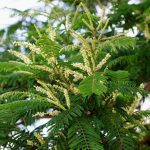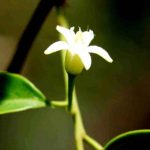TREE LIFE
May 1985
MASHONALAND CALENDAR
Saturday May 4th: Botanic Garden Walk. Please note change of day and time with winter.
Sunday May 19th: C. C. Cloete’s farm “Kujawy”, Gadzema to join up with the Chegutu folk. The area we plan to visit is where a new dam has just been built on the Serui River. This is very close to the Great Dyke and there is both riverine and kopje vegetation including Ficus nigropunctata, Olax dissitiflora, giant Croton gratissimus and Brachystegia glaucescens. A bus has been booked which will leave at 0830 from Monomatapa Car Park, where a guard will look after cars. Fare is $12.
LOWVELD GONA-RE-ZHOU TRIP, HEROES DAY WEEKEND, 1985
Further to the note in the last Tree Life our firm plan is to travel by Express Motorways coach departing from Harare at noon on Friday 9th August and returning to Harare on Monday evening 12th August.
We have had further contact with our hosts, the lowveld Natural History Society. They are kindly prepared to lay on the main catering if we contribute $25 per person. This is not only good value for money but also a means of reducing the amount of impedimenta to be carried and the attendant hassles. The idea is even more appealing if one imagines the convivial braai which is likely to await our arrival. The roads within the park are not suitable for a bus, although there is no problem getting to Chipinda Pools, so we have been promised transport from local sources and would like to pay our share of the fuel costs, the exact figure of which is unknown. In addition we need to pay campsite fees, $3 per night per campsite, each accommodating 6 persons.
With all this in mind it was decided to ask for a globular charge of $100 per person which we hope will cover everything. A three day trip to the other side of the country for this amount is very good value, especially considering that we will be in the company of very knowledgeable persons on the ground. We also hope that Tom Muller will be able to join us.
I will obtain better details with regard to equipment required. Hopefully will be able to arrange for the heavier stuff such as tents etc, to come locally and for say, stretchers etc. to be taken by us. More of that later.
In order to secure your places, please will you forward the $100 per person to our Treasurer Joy Killian, as soon as possible. This will be needed to pay our contribution to the LNHS and to secure our camp sites, which have been booked. Any questions or enquiries. Please contact me either at home, Harare 8871413 or work 702561.
-Phil Haxen
BOTANIC GARDEN WALK 2ND APRIL 1985
We decided to revise the figs, particularly those species we did not cover in August last year when we looked at the MORACEAE. We may remember our fig walk a few years ago when Dr. Berg visited us from Utrecht, well the herbarium has just received a very rough copy of Dr. Berg’s revision of the figs indicating the expected name changes. The 25 indigenous species of Ficus may be split into 8 different groups which, for simplicity, will be called taxa.
Taxon 1 : 1) F. exasperata 2) F. capreifolia 3) F. pygmaea
Taxon2 : 4) F. sycomorus 3. F. sur (= F. capensis) 6) F. vallis-choudae
Taxon 3 : 7) F. ingens 8) F. cordata (= F. salicifolia or F. pretoriae 9) F. verruculosa
Taxon 4 : 10) F. lutea (= F. vogelii)
Taxon 5 : 11) F. bussei (= F. ambesiaca, referred to as F. platyphylla in the August walk)
12) F. glumosa (= F. sonderi) 13) F. stuhlmannii 14) F. tettensis 16) F. abutilifolia (= F. soldanella)
Taxon 6 : 17) F. fischeri 18) F. craterostoma 19) F. natalensis ssp natalensis 20) F. thonningii (including F. burkei)
Taxon 7 : F. polita 22) F. chirendensis 23) F. sansibarica ssp sansibarica 24) F. bubu
Taxon 8 25) F. scassellati ssp scassellatii (= F. kirkii)
We wondered past the large F. sycomorus (taxon 2) opposite the lake. This species is common along lowveld rivers and may be found on the highveld where there is a high water table. Tom has tried hard to grow the associated species of ‘loranthus’ on these trees but without success. These trees have done well in 14 years although little can eclipse the growth of the F. vallis-choudae planted less than 4 years ago. We noted the stipular scars which completely surround the branches, in contrast to the stipules of taxon 1 which are lateral on the stem.
We passed what is now F. bussei on the lawns and re=examined F. ingens and F. verruculosa. In taxon 7 we looked at two very similar trees, F. sansibarica which we have seen at Shamva, Chegutu and Dichwe. This tree may be a forest strangler although it grows in savanna woodland as well. Moving around the forest past the Chlorophora we came to a large specimen of F. chirendensis, a species which has only just been recognized officially as being different from F. sansibarica. The herbarium specimens can only be distinguished by the presence of short oppressed white hairs on the stipules of F. chirendensis whereas the stipules of F. sansibarica are ciliolate. Ecologically F. chirendensis is a large forest strangler growing from branches often 10 – 15 m up. It reaches heights of 5 – 58 m. The other two species in taxon 7 can also be confused with F. sansibarica. All of them have large figs which grow on very short spurs off the main branches and trunk. Most are forest stranglers with smooth bark and glabrous leaves, twigs and figs. F. polita, which we saw later in the fig section, grows above the tea estates in the east whereas in Mozambique it is found in rain forest. This specimen showed the drip tip and long petiole. F. bubu we pass often in the gardens and only saw its ghostly trunk in the fast fading light.
On our circuitous route to get to the fig section, almost via the herbarium, we passed a small F. fischeri, taxon 6, with large leaves. This species is apparently interesting because further north where it is common it forms a flat topped crown like so many other savanna trees. In Zimbabwe it is only known from the Mt. Selinda – Sabi Valley road where the altitude drops from 1500 to 400m. Tom also showed us the other three species in taxon 6, a confusing collection. All tend to be stranglers. F. thonningii is the most variable with a number of forms which cannot be clearly defined at present. In the rain forests of Manicaland they become almost glabrous with a multitude of aerial roots. We saw F. natalensis at Henry Hallam Dam this month, it can be separated from F. thonningii as it has a truncated leaf, sometimes, with a midrib which seldom goes to the apex, its leaves may also be sub-opposite which does not usually occur in F. thonningii. The figs are on short stalks, in contrast to F. craterostoma in which the figs are sessile. F. craterostoma also has very truncated leaves which may be sub-opposite but it grows as an enormous strangler in Bunga forest. It has been suggested that stranglers often have small figs specially so that the birds can eat them and distribute the seeds into other trees. This would work for the taxon 6 group, but not taxon 7.
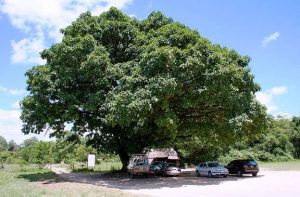
Ficus lutea. Photo: Bart Wursten. Source: Flora of Zimbabwe
Past the Dovyalis zeyheri we found a struggling specimen of F. nigropunctata, taxon 5. Gill Masterson pointed out one of these on the Young’s farm, Suri Suri, and we hope to see it again next month. It apparently may have black older wood, nigro, with conspicuous tenticals, punctata, although this was not apparent on this specimen. All the figs in taxon 5, except F. stuhlmannii, may be “rock splitters” where they are usually protected from fire although they grow in seasonally dry areas. They all tend to have a very lobed base to the leaf blade and except for F .abutifolia, a densely hairy to velvety texture to the young leaves, twigs and figs. F. nigropunctata grows in medium elevation woodland and has a wavy leaf margin. We saw another wavy edge in F. tettensis, with leaves like a geranium. This rock splitter has white roots and trunk and a peeling bark. It may be found in the Matopos and at Mudzi, beyond Mtoko. Tom took us over to a tall multi trunked tree with furry obovate leaves and a pinched trunk, this was F. stulmannii, although apparently the multi trunk is atypical. It grows in medium altitude woodland. We also saw F. abutifolia and G. glumosa. In the fig section we stopped at F. cordata spp. salicifolia, taxon 3, and noted how similar the figs were to the warty (verruca) F. varruculosa. This woodland species may be confused with F. ingens but in F. cordata the basal pair of lateral veins are unbranched and curved so as to run parallel with the leaf margin. In F. ingens these veins are straight and/or distinctly branched. F. lutea is the Scarlett O’Hara of the local figs; the widely flaring creases of the sprawling roots merge into a tightly pinched waistline. Directly above this short, narrow waist the branches emerge, spreading widely to the dense crown of large shiny green leaves with pale veins. It grows as a big tree in the Chipinga area, in dry forest.
Taxon 1 is rather interesting because it is to this group that the commercial fig, F. carica, belongs. Garden figs are the worst of all to demonstrate fig biology because the tree people grow is unusual as it only bears female flowers. Apparently these figs in taxon 1 may all have some plants which are only female as well as plants which are both male and female. The plants with both male and female flowers the female flowers may be so heavily parasitized by wasps that they never set seed and are therefore functionally male. Tom questioned whether F. exasperata is dioecious as his one tree in the gardens sets seed which grow up all over but then Prof. Wild had also planted a F. exasperata at the University very close to the gardens, and this specimen, now cut down, fruited profusely but never seeded. Dr. Phelps remembers collecting wasps from it so it may well have been male and fertilized Tom’s, or Tom’s may be ‘male’ in which fewer of the females are parasitized, does anyone have any further ideas? The F. capreaefolia is no spelling mistake, Berg spells it like that and so does Wiebas, a fig wasp specialist. Both of these figs have a sand paper feel. F. cappreaefolia is a colonizer of the sand along rivers, and F. exasperata is a forest strangler. The second last fig we saw on the walk was F. kirkii which, as my botany professor would say, “now rejoices in the name” F. scassellatii subsp. scassellatii. This forest strangler has warty figs with a marked beak and a leathery elliptical leaf. It may grow up to 50 m in rain forest. For anyone who is interested there is a stimulating article by Prof Janzen entitled “How to be a fig”. I will pass a copy of this paper to Georgie Granelli who is now in charge of the “interest file”. We must thank Tom once again for his time. In addition I hope Dr. Berg does not take offence at using his names before they are officially published. The subject of fig biology is so broad I have not even tried to cover it here, maybe some other time. –
-Kim ST.J. Damstra
OUTING TO HENRY HALLAM DAM, HARARE 21ST APRIL 1985
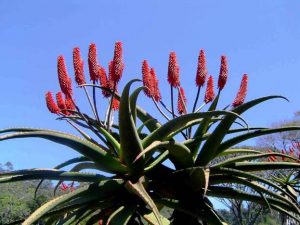
Aloe excelsa. Photo: Bart Wursten. Source: Flora of Zimbabwe
On Tree Society outings we walk around, look at trees talk about them and try to identify them. Our outing to the Henry Hallam/Prince Edward Dams was no different except on this occasion we were joined by folk from the Aloe, Cactus and Succulent Society, making our numbers considerably larger than usual. So in the morning we split into three groups and here I shall re-cap on the species looked at by our group. Although the number of aloes seen was limited to three, namely Aloe chabaudii, A. excelsa and A. zebrina, the number, variety and size of the trees was large and so we walked around looking at the trees trying to identify them by sight, feel, and smell as usual, and we hope our guests enjoyed the trees as much as we did.
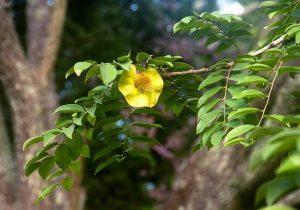
Pterocarpus angolensis. Photo: Bart Wursten. Source: Flora of Zimbabwe
Of course, we started with the msasa, Brachystegia spiciformis which has a terminal pair of large leaflets that dangle down and wave in the wind and smooth pods amongst the leaves, as opposed to Mnondo, Julbernardia globiflora which has furry pods borne on top of the tree above the leaves. In this neck of the woods the msasas were large, beautiful and dominant; towering over the many other trees we looked at. The next thing that caught our eye was Indigofera rhynchocarpa with hockey stick like pods. The name comes from the Greek “rhynochos” a snout and “karpos” a fruit and is descriptive. We also looked at the leaves and found that they were compound, being once pinnate, i.e. one rachis with leaflets arranged on either side, as compared with our next species which was Albizia antunesiana with its bi-pinnate leaf, i.e. the rachis divided and there were four little stems with leaflets on either side. This particular specimen had no purple leaves but we subsequently saw these purple leaves. Close by and also with a compound leaf was Swartzia madagascariensis the Snake-bean tree but without the pods. The previous compound leaves we looked at had opposite leaflets but this has alternate leaflets with the terminal one considerably larger than the others. That factor together with the rough bark made this unmistakable. Also unmistakable was Cassia abbreviata in pod. These very long velvety pods which obviously bear no relationship to the specific name which refers to the ‘rather abbreviated inflorescence’ (R.B. Drummond. Common Trees of the Watershed Woodlands’). We had a bonus as there was one unseasonal head of flowers; not too high up for us to examine closely. On either side was the mukwa, Pterocarpus angolensis, lovely in full pod. Because the pods of both the previous species are so distinctive we did not examine the leaves which are both once pinnate. C. abbreviata has opposite leaflets and P. angolensis has opposite to sub-opposite leaflets. Later we saw Pterocarpus rotundifolius also with opposite to sub-opposite leaflets but as the name “rotundifolius” suggests with very round, rotund, leaflets, folium. The name Pterocarpus is from the Greek ‘teron’ a wing and ‘karpus’ a fruit. Only the mukwa has bristles in the middle of the pod.
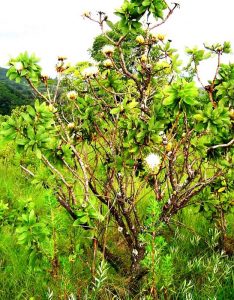
Protea welwitschii. Photo: Bart Wursten. Source: Flora of Zimbabwe
We also looked at Aeschynomene with little pods rather like a lorgnette, it was probably A. mimosifolia, and Crotalaria pallidicaulis with its characteristic swollen pods and trifoliate leaves. All the species I have mentioned so far belong to the Legume family which shows how common and widespread the family is. But before I leave the legumes, I must mention Mundulea sericea. ‘Sericus’ is the Latin for silky and usually refers to the silky hairs on the leaves which gives the plant a silver appearance. Mundulea, which we saw with lanceolate leaflets and characteristic leguminous pods, is a plant I usually associate with riverine area.
However, Leguminosae was not the only family we saw, nor have I mentioned all the members present. The Protea family was represented by Protea welwitschii, honey scented or multi headed Protea with its narrow velvety leaves and more than one flower per head – obviously just over they usually flower February/March and Protea angolensis, Northern Protea, in but and flower with its roundish smooth blue green leaves running into pink where the leaf joins the stem, Proteas often lack a leaf stalk or petiole, and thirdly Faurea speciosa, broad leaved Faurea, in flower showing its resemblance to the Banksia, a member of PROTEACEAE, indigenous to Australia and grown in gardens in this country. We also saw Faurea saligna, Willow Faurea. When not in flower or fruit the characteristic features of this genus is that the side veins meet just before the margin and run round the edge of the leaf. The leaves do have a petiole or leaf stalk.
A very exciting and lovely find was Croton gratissimus ‘gratissimus’ comes from the Latin ‘gratia’ which means ‘to please’ and this tree certainly pleases me, having leaves with a silver under surface dotted with red, and the odd orange leaf. They have an aromatic or lavender scent and also two little glands on either side of the leaf base, a feature that they share with other members of the Croton genus.
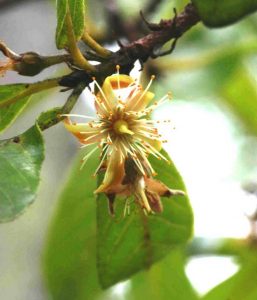
Monotes glaber. Photo: Bart Wursten. Source: Flora of Zimbabwe
Also with a gland, or extra floral nectar were Monotes glaber, distinguishable with their yellow green leaves, dark stems and dried flower like fruit. I have not yet mentioned Vitex payos with a digitate leaf; Allophylus africanus with its trifoliolate leaf and hairy pockets in the axils of the veins, Syzygium cordatum with its square branchlets and cordate or heart shaped leaves and no petiole or leaf stalk, and all the others.
We are indeed lucky to have such a place so close to town and so accessible. We must send our congratulations and thanks to the Officials of the City of Harare who have been and are now responsible for this wonderful amenity.
-Meg Coates Palgrave
Much of what our group saw has been covered in Meg’s account of the morning walk, so I won’t duplicate.
Two themes ran through our walk, the one being leaf arrangement and the other being smells. Both are used as a guide to recognition. Pseudolachnostylis maprouneifolia, the duiker berry, was used as a good example of a simple leaf, alternately arranged along the stem with a bud visible in each axil. Brachystegia spiciformis illustrated the pinnately compound leaf. Here the one pinnate leaf has leaflets arranged in opposite fashion on the rachis, equivalent to the midrib on a simple leaf. There is no terminal leaflet so it is termed paripinnate. Swartzia madagascariensis has a once pinnate leaf but this time with alternate leaflets. Lannea discolor was an example of a once pinnate leaf with opposite leaflets. Both of these trees have a single terminal leaflet, an arrangement known as imparipinnate. In the case of such single divisions the leaflet is called a pinna. If the leaf is again compounded the leaflet is known as a pinnule and the whole leaf is described as being bi-pinnate as in Albizia antunesiana. Here both the pinnae and leaflets are opposite. However in Burkea africana the pinna are opposite but the pinnules are alternate.
These last trees bring me to the next theme, that of smell; the genus Rhus at least in these parts has a fresh ‘apple green’ smell from the crushed leaf. Croton gratissimus has the scented smell of lavender. This contrasted sharply with the unpleasant smell of Clerodendrum myricoides seen a few minutes later. At the picnic site we found the rather unusual Zanthoxylum capensis. This belongs to the Citrus family and yields a distinct lemon smell.
Finally, to depart from these themes, I must report a rather unusual find. On top of a low ridge of granite, shaded by other trees was a grove of Synadenium sp. No. 1 ( S.grantii/kirkii), a succulent trees of the EUPHORBIACEAE which produces a copious and highly toxic latex. Exaggerated local legend says the tree is so toxic that the bones of its victims lie in profusion in its shade and birds flying over it will fall down dead! Well we saw no evidence of victims, but admired the numerous flowers instead.
-J.P. Haxen
The third group pottered around in the woodlands, playing with families and fairy tales, in a sensuous and semi serious botanizing adventure.
Kim ST.J. Damstra
MATABELELAND CALENDAR AND NOTES
Sunday May 5th: Meet at Retreat at 0830 hours for the Matopos in the area of the lower Outspan. It may well be advisable to bring lunch.
We met on Sunday April 14th at the Circular Drive and investigated the area just beyond the Big Mast, on that side of the road. It was a well chosen area, and we saw over 60 species in very pleasant weather. Acacias were few, only A. karroo and A. rehmanniana, Albizia amara, Albizia antunesiana, Azanza garckeana grew singly among many Dombeya rotundifolia, these two are so often confused. A very white Brachylaena rotundata had rather pointed leaves. Bridelia mollis and Burkea africana were both rather stunted, the area being rocky. One very miserable Canthium lactescens, for the same reason, Carissa edulis, with an occasional “Y” thorn. Cassia abbreviata had us stumped for some time, being coppice growth along a rock crevice; Clerodendron glabrum and C. myricoides, Combretum apiculatum, Combretum molle, Commiphora mollis, Cussonia natalensis, also a very tall Cissus cornifolia, well over 2m. Dalbergia melanoxylon, Dichrostachys cinerea, Diplorhynchus condylocarpon, Dovyalis zeyheri, many Erythrina latissima, some with very large knobs, rather than prickles on the stems, Euclea natalensis, Euphorbia ingens in flower, Bauhinia thonningii, Faurea saligna, Ficus glumosa and what we decided was Ficus thonningii, we are a little unsure of some figs, Flacourtia indica, in somewhat large fruit, Grewia monticola in fruit, Iboza riparia, Lannea discolor, Maytenus heterophylla, M. senegalensis, Mimusops zeyheri, Mundulea sericea, seeding profusely, Osyris lanceolata, Ozoro insignis, Pappea capensis, Parinari curatellifolia, Pavetta gardeniifolia, Pavetta schumanniana, Peltophorum africanum including one which imitated a strangler or rock splitting Fig with a large piece of rock being well strangled, Protea guaquedi in full flower, Pseudolachnostylis maprouneifolia in fruit, Pterocarpus angolensis in pod, Rhoicissus tridentata, one of which seemed to be Rhus tenuinervis. However, a later comparison of samples taken, suggested that they were both Rhoicissus. Sclerocarya birrea, Securinega virosa, Sericanthe andongensis, Strychnos spinosa, Tapiphyllum velutinum, at first sight not unlike Vangueria, showing the RUBIACEAE family resemblance, Terminalia sericea, Turraea nilotica, all very small, Vitex payos, in ripe fruit, which on eating we found reminiscent of dates, Ximenia caffra and Ziziphus mucronata in fruit.
-C. Sykes,
-KIM ST. J. DAMSTRA ACTING CHAIRMAN


